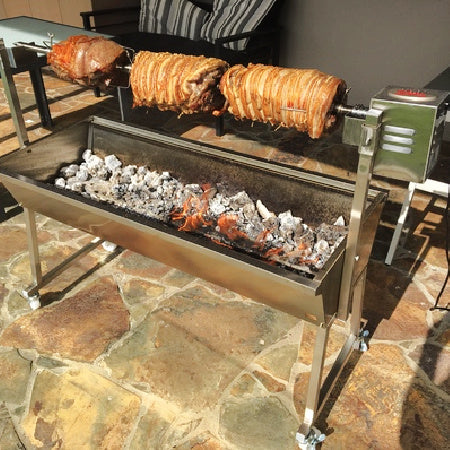
Spit Roasters | An Introduction
Table of Contents
Introduction:
Picture this: an inviting aroma wafting through the air as succulent meats slowly rotate over an open flame. This delightful scene is made possible by the versatile spit roaster, a cooking apparatus that has been captivating food enthusiasts for centuries. In this blog post, we will explore the fascinating world of spit roasters, delving into their different styles, cooking techniques, and the array of meats that can be prepared to perfection on these remarkable devices.
The Spit Roaster: A Grilling Marvel
The spit roaster, also known as a rotisserie, is a cooking method that involves skewering food onto a long rod or spit, which is then rotated slowly over a heat source. The rotation ensures even cooking and locks in juices, resulting in incredibly tender and flavourful meats. Whether you're a seasoned pitmaster or an adventurous home cook, the spit roaster offers a versatile and exciting way to prepare a wide variety of dishes.
Styles of Spit Roasters:
- Open Fire Spit Roaster: This classic style of spit roasting involves suspending the spit over an open flame. It's a primal and captivating cooking method that adds a rustic charm to your culinary experience. Open fire spit roasters are often used in outdoor settings, such as barbecues, camping trips, or backyard gatherings.

- Gas or Electric Spit Roaster: For those seeking convenience and control, gas or electric spit roasters are excellent options. These modern iterations allow for precise temperature regulation, ensuring consistent and even cooking. Gas or electric spit roasters are ideal for indoor cooking or situations where open fires are restricted.

Unleashing your Grilling Creativity:
- Prime Cuts of Meat: Spit roasters are particularly well-suited for cooking prime cuts of meat, as the slow rotation helps to retain their natural flavours and tenderness. Succulent whole chickens, juicy roasts, and melt-in-your-mouth racks of lamb are just a few examples of the culinary masterpieces you can create.
- Adventurous Experiments: Take your spit roasting skills to the next level by exploring unconventional meats. Whole suckling pig, game birds like quail or pheasant, and even whole fish can be transformed into gastronomic delights with the gentle rotation of a spit roaster. Embrace culinary experimentation and surprise your guests with unique flavour profiles.
- Marinating and Seasoning: Enhance the taste and texture of your meats by marinating them before placing them on the spit roaster. Experiment with aromatic spice rubs, herb-infused marinades, or tangy citrus blends to create tantalizing flavour combinations that will have your guests coming back for more.

Tips for Spit Roasting Success:
- Properly Prepare the Meat: Ensure your meat is properly trimmed, tied, or trussed before skewering it onto the spit. This helps the meat cook evenly and prevents it from falling apart during the roasting process.
- Temperature Control: Maintain a consistent cooking temperature by adjusting the distance between the heat source and the meat. This will help prevent excessive charring and ensure the meat cooks evenly.
- Basting and Juices: Regularly baste the meat with flavourful liquids, such as marinades or natural meat juices, to keep it moist and add an extra layer of flavour. Collect the dripping juices and use them for a delectable sauce or gravy to accompany your finished dish.
- Resting and Carving: Allow the meat to rest for a few minutes after removing it from the spit roaster. This allows the juices to redistribute, resulting in a more succulent and tender final product. When carving the meat, use a sharp knife to slice it against the grain. This ensures maximum tenderness and allows for an optimal dining experience.
Elevating the Spit Roaster Experience:
- Flavourful Wood Chips: Add an extra layer of flavour to your meats by incorporating wood chips into your spit roasting setup. Soak the wood chips in water or a flavourful liquid, such as beer or wine, and place them on the heat source to create aromatic smoke. Different types of wood, such as hickory, apple, or mesquite, impart distinct flavours, allowing you to experiment and customize your culinary creations.
- Side Dishes and Accompaniments: While the star of the show is undoubtedly the spit-roasted meat, don't forget to complement it with delicious side dishes and accompaniments. Grilled vegetables, buttery corn on the cob, roasted potatoes, or fresh salads add texture, colour, and a well-rounded meal experience.
- Socialize and Share: Spit roasting is not just about the food; it's a social experience that brings people together. Invite friends and family to join you in the excitement of spit roasting and create unforgettable memories around the tantalizing aromas and flavours.

Conclusion:
Spit roasters unlock a world of grilling possibilities, from traditional roasts to daring experiments with unconventional meats and flavour combinations. Whether you opt for an open fire spit roaster or a modern gas or electric version, the art of spit roasting allows you to showcase your creativity, elevate your cooking skills, and indulge in mouth-watering dishes that will impress even the most discerning palates. So, gather your loved ones, fire up the spit roaster, and embark on a grilling adventure that will leave a lasting impression on all who partake in the feast.
If you want to see a more in depth blog on Spit Roasters check out our Ultimate Guide here



Leave a comment